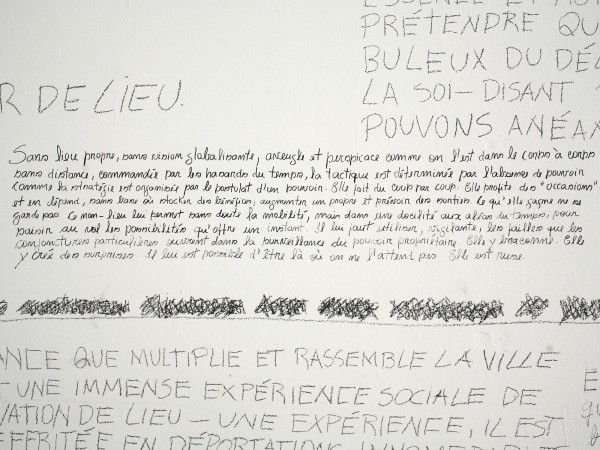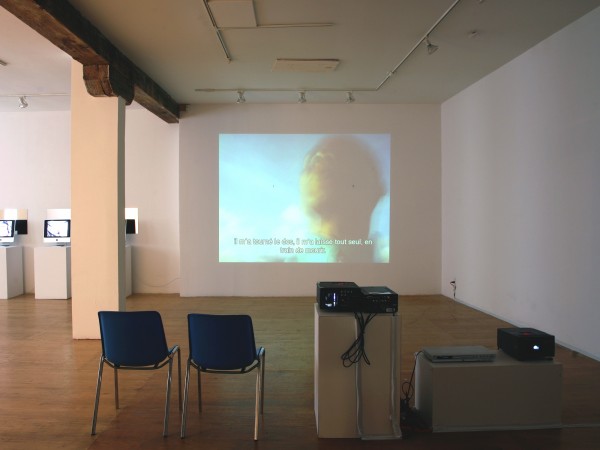Against the grain
par Fnoune Taha
Virginia de Medeiros
from October 19 to November 11, 2007
″Come, enter the circle, we will all squeeze up to make room. We have been waiting for you. If we retain only one fact relating to him, it would be a thought that was so familiar, so necessary to him, speaking of his most intimate conviction: that one must always ″make space for the other.″1
Virginia de Medeiros was born in Feira de Santana in 1973. The Brazilian artist’s exhibition at LA CHAMBRE BLANCHE consisted of video works, produced during her stay and site-specific work in Quebec City. Following the completion of her Masters in Visual Arts, de Medeiros decided to pursue her own artistic experimentation. Before focusing on the medium of video, her work centered on painting, followed by photography, resulting in a series entitled Femmes pré-moulées (1995). This series marked out the terrain of future enquiries, notably attitudes to the body and relations with the other, and the social position of women. The work that she undertook during her residency in Quebec focused on the notion of the ‘fault’. The word ″fault″ is (nowadays) part of everyday speech, and defines disruptive elements that do not fit within conventional forms of order. That said, the artist sought to stay as close as possible to the etymology of the word. In geological terms, ″a fault is a planar fracture or discontinuity in a volume of rock, across which there has been significant displacement. Active faults are the cause of most earthquakes.″2
This geological definition was born out fully in the artist’s work, in terms of her analysis of the differences and similarities between the city of Quebec and that of Salvador in Brazil. Like Salvador, Quebec is constructed on two levels, possessing a downtown and uptown area. This separation in the urban landscape is revelatory of the social inequality and prejudices that have set in over time. These two distant cities, both in terms of geography and culture, found themselves juxtaposed through an approach that did not seek to simply critique; it was not a matter of noting that the richer part of the population live uptown whilst those less well off live downtown. Rather, the project sought to infiltrate the two cities through the heart of the fault that lies within them.
According to Virginia de Medeiros and her collaborator, the urbanist Silvana Oliviéri, initially speaking, a ″fault″ is a term describing the marginal, those who are excluded by society because they have chosen to live outside of the system. In Salvador, the artist recounts the story of the transvestite Simone and that of Mae Preta. In Quebec, Virginia decided to follow itinerants in the Saint-Roch downtown area. Despite the differences between the two worlds, the artist adopted the same methods, doggedly pursuing individuals able to introduce spectators to other realities.
The public entering LA CHAMBRE BLANCHE’s exhibition space were immediately drawn towards a projection of the film Gardienne de la fontaine, produced in 2007. The images show a young Brazilian transvestite, Simone, avidly explaining her ″reconversion″ thanks to God’s love. He tells Virginia how, following a crack overdose, he changed from being a transvestite to a man of faith, preaching to all who will listen of his expiation and his new life. In a kind of mystic delirium, that the artist notably shares in, Virginia follows Simone both as a woman and in the subject’s new state as a man. We quickly understand that Simone is a loner, rejected by those around her. This solitude is underlined by the filmic effects that the artist employs, often placing herself behind the subject and only rarely appearing on camera. Similar to an anthropologist, the artist seeks to keep an objective distance from the object of her research. At the same time, it is this very sense of distance that enables the spectator to understand that what he/she is witnessing via the camera is above all a gaze. This is a vision that, ultimately, marks a form of questioning that is far from deterministic in nature.
How to be a woman? Is Simone a broken mirror of ″womanhood?″ By treating the body as a form of representation, the artist is able to draw the spectator into a deep reflexion on his/her own position in the social fabric and relationship with otherness. Virginia de Medeiros’s work with Silvana Oliviéri aims to be transgressive. It shows the appropriation of social codes by an individual, and how this appropriation becomes itself problematic. The ″unstable″ gender of the transvestite continually blurs the characteristics associated with femininity and masculinity. Numerous authors have insisted that femininity and masculinity are not concepts with a grounding in nature. Rather, femininity is a genre, a psychological and physical construct.
According to Judith Butler, a key figure in Queer and Gender Studies, ″To say that gender stems from a form of doing, is merely to state that it is not fixed in time, not a given; it also points to the fact that it is constantly unfolding, even if the form that it takes creates the appearance of something natural, preordained and determined by a structural law. If gender is made, constructed, through certain norms, these same norms are the form that it takes, that which renders it socially intelligible.″3
Moreover, Virginia de Medeiros and Silvana Oliviéri perceive identity not as something that is fixed, but as something that perpetually encounters forms of tension. It is through the prism of these differences that an individual can question his/her essence. The Brazilian artist ″sublimates″ these differences, which, ultimately, become a form of artist material. In this artist’s eyes, accepting alterity means each of us embracing the idea of inner upheaval. According to de Medeiros, difference is, “an agent of transformation.”
La gardienne de la fontaine does not recount the story of Simone, it also deals with Mae Preta, an elderly lady who tells us of the difficulty of her life in Salvador. After her home burned down, she was forced to look for new accommodation, despite having few means. Like Simone, Mae Preta was forced to leave behind and redefine her makeup as an individual. Whether it is in terms of identity issues or localizing oneself in the urban context, the characters in the video reinvent their relationship with the city. For example, every day Simone takes care of an abandoned fountain, gathering and burning rubbish, and cleaning the structure in what almost amounts to a pagan rite. The videos shown in the exhibition in Quebec City also showed how itinerants in Saint-Roch appropriate certain sites.
One influence makes itself consistently felt in Virginia’s art practice, that of Michel de Certeau and his book The Practice of Everyday Life4. The artist’s exploration is nurtured by two notable concepts from this seminal work, first published in French in 1980. In defining our relationship with the city and areas within it, Michel de Certeau spoke of strategies and tactics. Strategies involve an approach to power that seeks to locate the subject within subject/object relations. Strategies seek to accumulate a significant amount of goods in order to transform these into profit. Meanwhile, tactics represent ways of life for inhabitants of a given space, for example, going to the market, or drinking a coffee every day in the same cafe. Thanks to an understanding of tactics, the subject/inhabitant is able to create a more poetic relationship with his/her immediate environment, reinventing the everyday, from day to day. Tactics become, “the art of doing” that makes use of faults in the dominant system in order to reinvent itself. However, tactics do not enable one to entirely free of the system. Above all, they introduce the possibility of implementing a distance between oneself and systems. Tactics may also take the form of margins, wherein forms of otherness breath other ways of being in the city. The fact remains that observing these subtle shifts required a committed involvement on the part of artist in working with the people filmed.
Virginia de Medeiros set out to research the everyday experiences of those living in the Saint-Roch area, and their view of the process of revitalization that the area is undergoing. The moments of life that the artist shares with the participants represent these experienes, and constitute emotional encounters that move the artist as deeply as her subjects. A ″fault″ can produce creative energy. The position of the artist becomes fragile, as the encounter with the other is transformed into a necessity. Ultimately, the video works presented at LA CHAMBRE BLANCHE embody the possibility of envisaging our environment in ways other than through the grid of identity that at times may seem insurmountable.
- Giard, Luce and Michel de Certeau.1980, The Practice of Everyday Life: The art of making-do tI. Paris: UGE editions, pp. 33-34.
- Wikipedia [online]. http://en.wikipedia.org/wiki/Fault_%28geology%29 (consulted on November 11, 2007).
- Extract from the paper ″Faire et defaire le genre″ (Undoing gender) , by Judith Butler, Professor at the University of California in Berkeley, given on the 25 May 2004 at l’Université de Paris X-Nanterre, in the context of CREART (Centre de Recherche sur l’Art) and the doctoral program ″Connaissance et Culture″
- Certeau, Michel de, Luce Giard and Pierre Mayol. 1980, The Practice of Everyday Life: The art of making-do tI et Living and Cooking tIII. Paris: Gallimard editions. 416 p.

